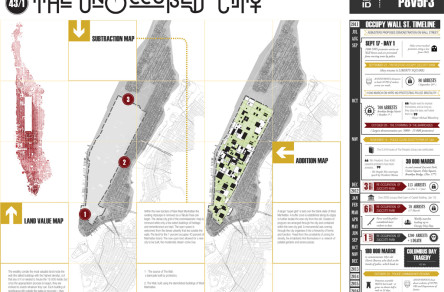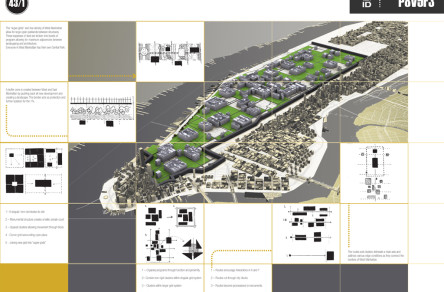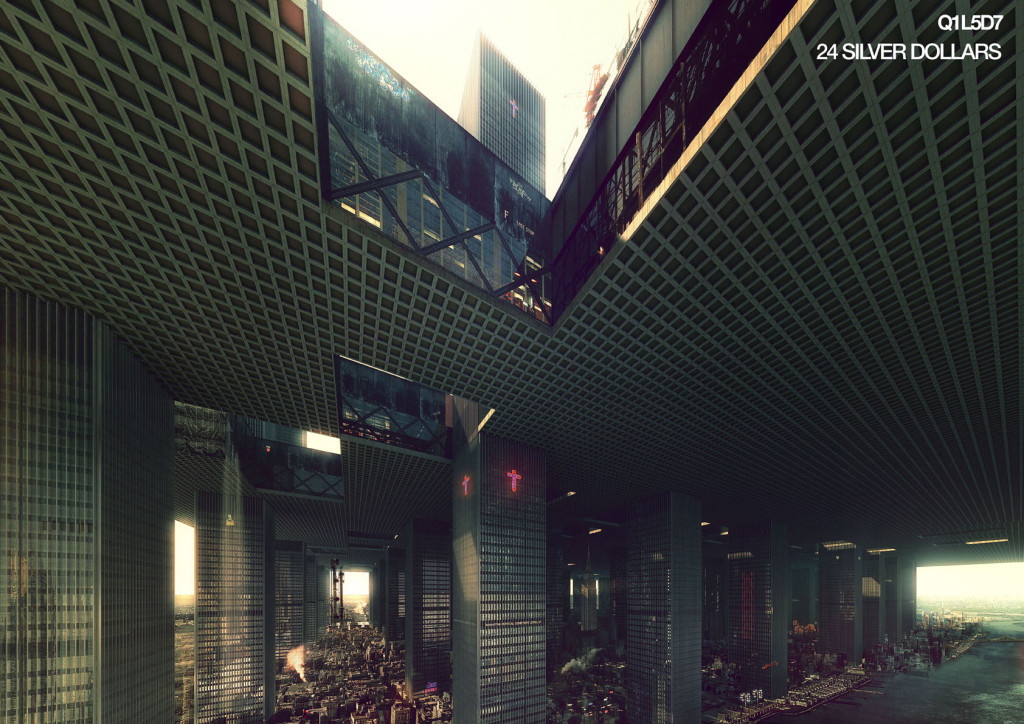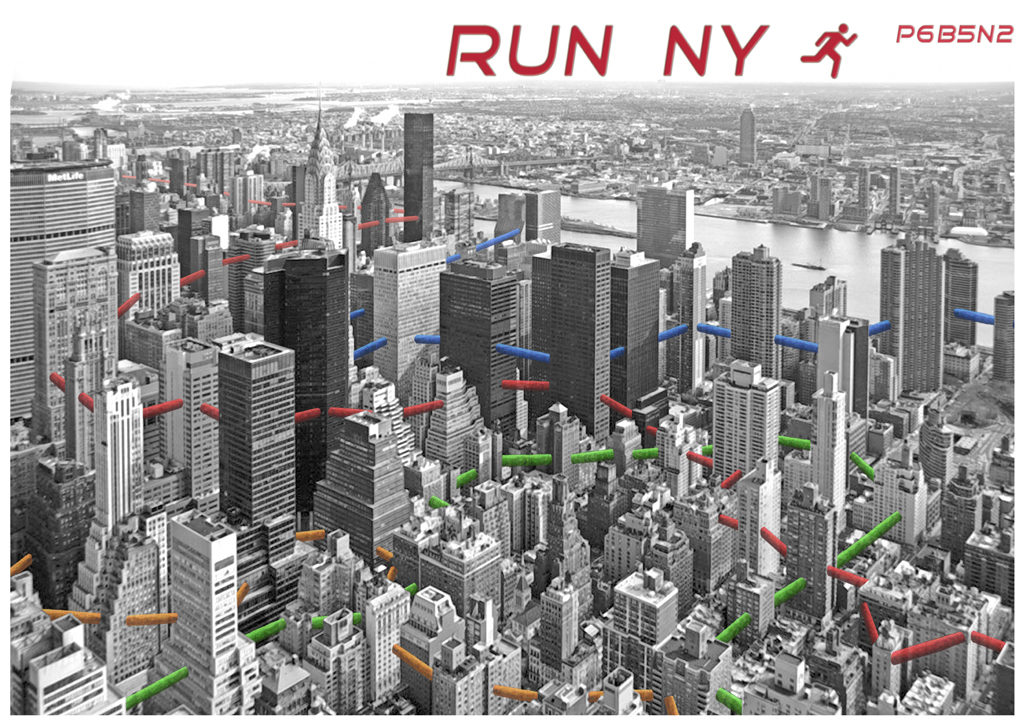Info:
Title: The Unoccupied City - Code: P8V5F3Contest: NY / 2012
By: R. Benadé - B. Evan Krom
Views: 2579 Likes: 0
Votes:
JOSHUA PRINCE-RAMUS2 EVA FRANCH I GILABERT2 ROLAND SNOOKS0 SHOHEI SHIGEMATSU4 ALESSANDRO ORSINI2 MITCHELL JOACHIM32.2
The Unoccupied City

 43 / 1 : The Unoccupied City It all started with the writing on the wall. It was September 17th, the anniversary of the Occupy movement – five years to the day that the first tents had been pitched in Zuccotti Park – and someone had painted a banner that read: HAPPY BIRTHDAY OWS ! MAY YOU GET WHATEVER THE HELL IT IS YOU WANT on the boundary wall of the Liberty Street church. The artist had painted happy balloons and fireworks on either side. A crowd gathered and the occasion, they decided, ought to be celebrated. They would hold a wonderful party and sing themselves happy birthday. “We’ll bake the cake!” promised one group of girls. “We’ll get the fireworks!” shouted some men. Streamers, confetti, birthday punch, birthday hats, balloons and bouncy castles – everyone had a task. “And spread the word!” said a big, fat man at the front. “Spread the word! Spread the word!” echoed everyone else.
43 / 1 : The Unoccupied City It all started with the writing on the wall. It was September 17th, the anniversary of the Occupy movement – five years to the day that the first tents had been pitched in Zuccotti Park – and someone had painted a banner that read: HAPPY BIRTHDAY OWS ! MAY YOU GET WHATEVER THE HELL IT IS YOU WANT on the boundary wall of the Liberty Street church. The artist had painted happy balloons and fireworks on either side. A crowd gathered and the occasion, they decided, ought to be celebrated. They would hold a wonderful party and sing themselves happy birthday. “We’ll bake the cake!” promised one group of girls. “We’ll get the fireworks!” shouted some men. Streamers, confetti, birthday punch, birthday hats, balloons and bouncy castles – everyone had a task. “And spread the word!” said a big, fat man at the front. “Spread the word! Spread the word!” echoed everyone else.
By night-time, a buzz of excitement and anticipation was boiling up in the assembled crowd. Then, as if an invisible conductor had tapped his baton on an invisible lectern, they started singing in perfect unison. At happy birthday dear… the synchronicity fell apart, and the song was dedicated variously to Occupy Wall Street, to OWS, to the names of everyone whose birthday it also happened to be, to New York, to Us.
All the while, the presents were piling up at the intersection of Broadway and Wall Street: stolen BMW’s and Mercs, Televisions and hotdog stands, even things that had been bolted down: post-boxes and parking meters. Everything went on the pile and soon the street was clogged with presents.
Protesters, who had previously attempted to storm the police barricades and failed, now decided to build their own. It was during the fireworks display that over-zealous partygoers decapitated The Charging Bull and paraded its head down Wall Street to the cheers and applause from the crowd. By midnight, the entire Financial District was overrun.
Government suppression of the riot over the following days was met with widespread disapproval, as images of ice-cream and cake eating party-goers being beaten and tazered surfaced in the local and foreign press. Policemen, asked to suppress an ever-growing insurgency of friends and family, deserted their posts. Additional protests sprouted in Harlem, Alphabet City, as well as support protests at the UN Headquarters in Turtle Bay. The barricade had spread erratically and was becoming a formidable fortification.
The party, if it could still be called that, carried on for weeks, then months and at the end of the year, most of Lower Manhattan had been walled off. Due to mounting international pressure to resolve the matter the decision was made, by an exasperated mayor, to build a wall through Manhattan, separating East from West. The governing elite and about 15 000 people would be given 43% of the land – the valuable real estate south of Harlem and West of Madison Avenue, including Central Park – while the rest would be conceded to the 99% to govern however they saw fit.
In order to build The Wall and make the city inside known as West Manhattan entirely self-sufficient, the existing grids and structures were eradicated and only a few key features remained standing. In their place, a palatial network of gardens and civic amenities was implemented, inspired by the baroque planning of old Versailles.
East Manhattan became known by many names: The Occupied City, 99 City, Libertyville, Anonymous Town and so on. Its inhabitants hoped it would be an egalitarian society, in which decisions were made because they were beneficial to many, not profitable to a few. They were optimistic that this could happen and there was much discussion about it.
Yet as the buildings fall into disrepair and the infrastructure of half of Manhattan strains to support 99% of its populace, the future of the Occupied City appears fragile, and the need for resolve, ever more urgent.






